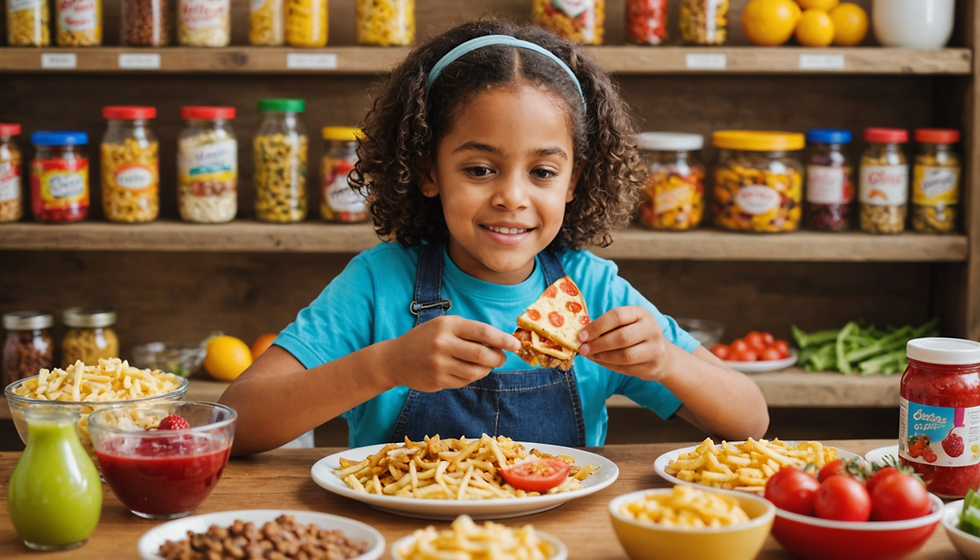The Red Dye 3 Ban: Harmful Additives in Your Child's Diet and Safer Alternatives
- Manny A

- Jan 15
- 4 min read
Updated: Jan 19

In an era where convenience often trumps quality, many parents are unwittingly exposing their children to a host of food additives that might not be as harmless as they seem. From vibrant colors to extended shelf life, these additives serve multiple roles, but at what cost to health? This article aims to shed light on some of the most common and potentially harmful additives in children's diets, focusing particularly on the recent developments regarding Red Dye No. 3.
The Harmful Additives Lurking in Your Child's Diet
1. Artificial Food Colors
Red Dye No. 3: A significant update in the food industry is the U.S. Food and Drug Administration's (FDA) decision to ban Red Dye No. 3 from food and ingested drugs due to its link with cancer in animal studies. This dye, which imparts a bright cherry-red color to products like candies, cereals, and beverages, has been under scrutiny for over three decades. The ban, effective from January 15, 2027, has sparked conversations about the safety of other synthetic dyes like Red 40, which some advocate should also be removed from our food supply.
Other Dyes: Dyes like Yellow 5, Yellow 6, and Blue 1 have also been associated with hyperactivity and other behavioral issues in children. Research points to a potential increase in ADHD symptoms among sensitive children, prompting some countries to require warning labels on foods containing these additives or even ban them.
2. High Fructose Corn Syrup (HFCS)
While HFCS does not contain artificial colors, its omnipresence in processed foods is concerning due to its link with obesity, diabetes, and heart disease. The fructose in HFCS is metabolized differently than the glucose in traditional sugars, potentially leading to liver stress and fat accumulation.
3. Preservatives like BHA and BHT
These preservatives are used to extend shelf life but have been linked to cancer in animal studies. Their presence in cereals, snacks, and baking mixes is a point of concern for many health advocates.
4. Monosodium Glutamate (MSG)
Although generally recognized as safe by the FDA, MSG has been associated with headaches, nausea, and other reactions in sensitive individuals. Its use in flavor enhancement, particularly in snacks and prepared meals, is widespread.
Symptoms and Concerns
Children might not immediately show symptoms from consuming these additives, but over time, effects can manifest as:
Behavioral Changes: Increased hyperactivity, attention problems, mood swings.
Physical Health: Allergic reactions, digestive issues, potential long-term health risks like cancer or metabolic disorders.
Safer Alternatives for a Healthier Diet
1. Natural Food Colorants
Instead of synthetic dyes, use natural alternatives like:
Beet juice for red,
Turmeric for yellow,
Blueberries or purple cabbage for blue/purple.
These not only provide color but also additional nutrients beneficial for health.
2. Reducing Processed Foods
Opt for fresh, whole foods which naturally lack these additives. Home cooking allows control over ingredients, ensuring that only safe, healthy components make it into your child's meals.
3. Natural Sweeteners
Swap out HFCS with natural sweeteners like honey, maple syrup, or even fruits when possible, which offer additional vitamins and antioxidants.
4. Preservative-Free Options
Choose products labeled "preservative-free" or use natural preservatives like lemon juice, vinegar, or salt in homemade foods.
5. Flavoring with Real Ingredients
Use herbs, spices, and real food sources for flavor rather than relying on MSG or other artificial flavor enhancers.
Red Dye No. 3
The recent ban on Red Dye No. 3 by the FDA signifies a pivotal moment in food safety regulation. This action has been long awaited by consumer groups and health advocates who have campaigned against this additive since it was linked to thyroid tumors in rats. The decision reflects a broader reevaluation of food additives, with discussions trending on platforms like X about the safety of our food supply and the need for more stringent regulations. The ban has set a precedent, potentially paving the way for scrutiny of other dyes and additives, highlighting a shift towards prioritizing consumer health over product appeal.
Actionable Steps for Parents
Read Labels: Always check food labels for artificial dyes, preservatives, or high levels of sugars.
Educate Yourself: Stay updated with the latest food safety news and research on additives.
Advocate: Support or engage in movements for cleaner food options by choosing products from companies that prioritize health.
Prepare Meals at Home: This is the best way to ensure what goes into your child's food is safe and nutritious.
The journey towards a healthier diet for your children begins with awareness and action. The ban on Red Dye No. 3 is just one step, but it underscores the importance of questioning what we consume. By opting for natural alternatives and reducing reliance on processed foods, we not only protect our children from potential health risks but also instill in them habits that could lead to a lifetime of health and wellness. Let's embrace this change, advocate for safer food practices, and ensure our children's plates are filled with the goodness of nature, not the hazards of industry.









Comments